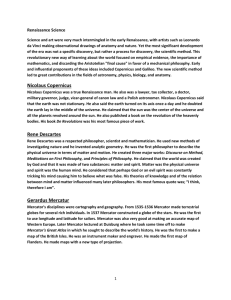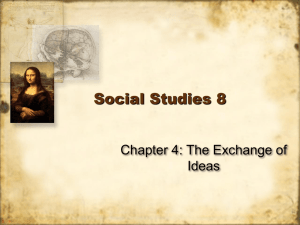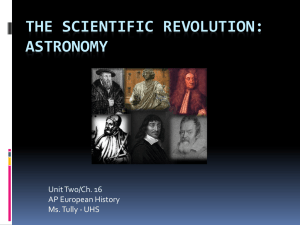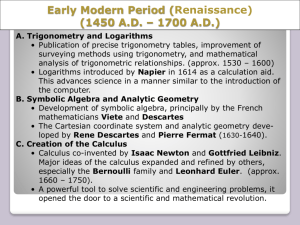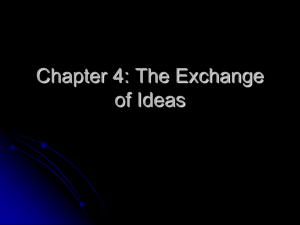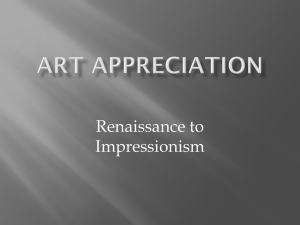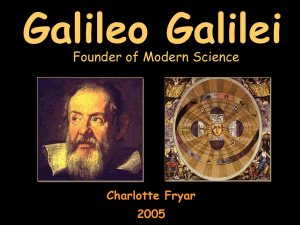Chapter 4
advertisement
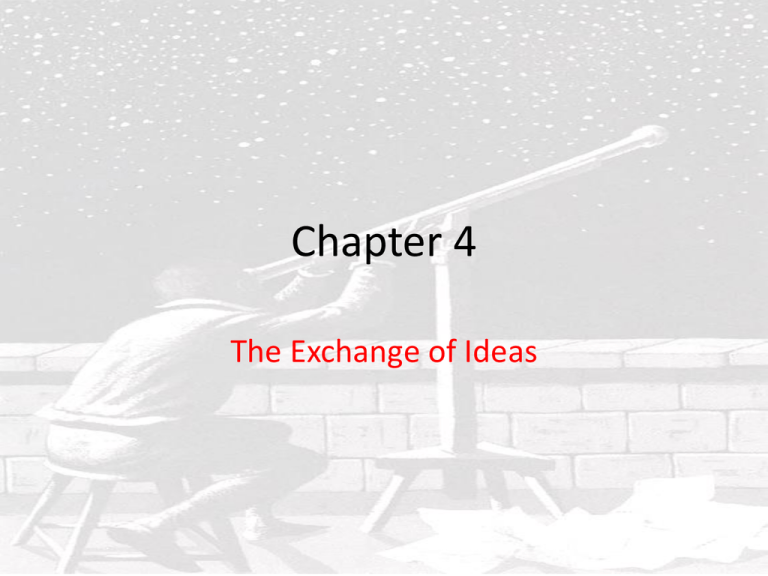
Chapter 4 The Exchange of Ideas • Read the chapter opener, in which Galileo appears before Church officials on a charge of heresy. • Why would the Church of Galileo’s time consider his Sun-centred theory to be heresy? • The Church believed in a Creator God and so it made sense to them that God would place Earth at the centre of the universe as they knew it. • According to the story, why was Galileo sentenced to house arrest? • Galileo was arrested for disagreeing with traditional, official church teaching of a geocentric (Earth-centred) planetary system. • With which elements of the worldviews icon did Galileo’s knowledge conflict? • His ideas conflicted with belief, although the Cardinals would have said his ideas conflicted with knowledge • Figure 4-1 What does Galileo’s experience tell us about how difficult it is to change a worldview? • It was many years before Galileo’s theories were adopted by mainstream thinkers. Galileo had publicly renounced his beliefs. Science: A New Way of Seeing • read page 80 • On a T-chart, record the view of science that existed at the beginning of the Renaissance in the left column and the view of science held by the humanists, including Leonardo da Vinci, in the right column. • Read da Vinci’s quotation out loud. • How would this view of science, and the introduction of the scientific method, change the work of scientists. Examine and discuss Figure 4-3 which visually represents the scientific method. • Why do you think the scientific method is so effective. • Step 7 is important because it points to the importance of verifying results. • think about how you felt when an idea you thought was true was called into question (e.g., Santa Claus). • read page 81. • suggest ways in which the new ideas in astronomy would have threatened the old worldviews that had long been accepted. • read pages 82 and 83 • Think about the following as you read how new ideas in medicine helped to shape worldview: • - What idea in these pages did you find the most surprising? Why? • - Which idea do you think would have been the hardest for people to accept? • Video: Renaissance Science and Invention • Homework questions • What is the Scientific Method – explain in words and in a diagram. • During the Renaissance in what areas were the most significant scientific advances? • Who was Ptolemy and what ideas did he introduce to the world? • Who was Copernicus and what ideas did he have about the Universe? • What did Galileo believe about the universe? Why were his ideas controversial? • Create a series of diagrams to demonstrate the differences in the theories of the universe. • During the Renaissance, Doctors did not know a lot about anatomy, how did they come up with remedies for illness and disease? • Who was Andreas Vesalius and what was he known for? • Who was Francois Rabelais and what was he known for? • Examine Figure 4-12 on page 83. How do you think knowledge of the human body might have helped Michelangelo create his David on page 58? • How did Mathematics develop during the Renaissance and how did Mathematics play an important role in Europe’s changing economy? • Answer questions on page 87 – Over to You # 1 & 2. Political and Religious Leadership • Generate a class list of qualities you look for in a good leader. • read all of page 88 • refer to the list of leadership qualities you generated and identify those qualities that Isabella D’Este possessed. • most women in theRenaissance were not in positions of power; they usually only gained power as extensions of their husband or son. • As you read page 89, consider Machiavelli’s ideas under the headings, “Machiavelli the Good” and “Machiavelli the Bad.” • You can record ideas you agree with under “the Good” and ideas you disagree with under “the Bad.” • answer the “Exploring Sources” question: Compare Machiavelli’s ideas about leadership with those of Isabelle D’Este. Which do you think would be more effective? Explain your thinking. • Changes in Leadership notes • Get into groups of four… • Momentarily, you will be numbered off one through 4. Each of you will go to one of the 4 assigned EXPERT groups and complete a brief summary. You will have approximately 10 minutes to do this. • Group #1 Page 92 • Group #2 Page 93 • Group #3 Page 94 • Group #4 Page 95 • When finished, return to your original group of four and share your EXPERTISE with your other four group members. They will do the same for you. When you are done, you will have information on all four readings • Read “Fast Forward” on page 96 and discuss, and answer the questions. • HOMEWORK • Generate a list of contemporary individuals who risk or have risked imprisonment and even death for expressing ideas they believe are important—their worldview. Make sure you can explain what these worldviews or ideas where. • do some research by talking with your parents, other adults in their community, or going online. • Examples: Nelson Mandela, Salman Rushdie, and Aung San Suu Kyi. The Spread of Ideas • Brainstorm ways that ideas and knowledge are spread in today’s society. • in this section, students will consider how ideas were spread before we had all of the communication technology that exists today. • What factors that would have influenced the spread of ideas during the Renaissance, • e.g., the time it took to travel from one city to another. • In what ways do you think modern communication technology affects your worldview? • During the Renaissance one popular way to exchange ideas was by gathering great minds. • Read “Gathering Great Minds” pages 97 and 98. As you are reading, jot down words that come to mind as you think about what it might have been like to be part of the gathering of great minds. • Perhaps words like exciting, prestigious, intense. • What similarities and differences exist in people’s views on the exchange of ideas between the gathering of great minds in the Renaissance and the gathering of people to exchange ideas today? • It was something only the elite did during the Renaissance, today people from all walks of life have opportunities to gather to exchange ideas; in the Renaissance and today, scholars can be celebrities. The Printing Press: A New Technology • Together read pages 98–100 and identify three changes that resulted from the development of the printing press. • In partners read and prepare a response to “Think It Through: consider a dilemma” (page 100). • Read “The Printing Press—Its Role Today” and “Canadians and the Internet” (pages 101–102). • Read “Zoom In,” page 101, and discuss, • What do you think are the important ideas in Michel de Montaigne’s way of thinking, as described by Kathryn Hinds. • What can you, as a Grade 8 student, learn from his ideas and apply in their own lives?



